If you would like more than 8 samples, please contact a trader directly.
Cart
A trader will contact you with shipping and payment options after checkout. Please note: free samples are provided to commercial roasting businesses only.
West Nile. Birthplace of Idi Amin and most recent home to Joseph Kony. Known now only for Zika, Ebola, and one other virus whose name I forget.
But it’s also home to Erussi, Paidha, Arua, Zombo –colorful places untouched by history’s paintbrush. These are places in West Nile, the forgotten northwest corner of Uganda; a place so close to the DRC that the border is barely a formality.
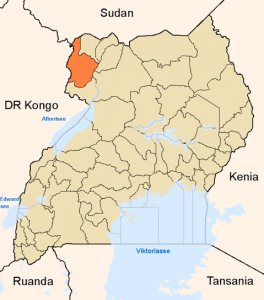
And these are places that are full of people. A proud, productive people who we found to be both easy to smile and eager to learn.
The people are Alur, of the Alur Kingdom, the clans of beads and spears. Sons of Sudan, brothers to the Acholi, divided only by the Nile. And they grow coffee.
Wonderful, wild coffee of classic Kenyan cultivars. Cultivars which have taken well to a climate that pendulums between harsh and lush. The place is perfect for coffee in all ways – except one.

It’s far. Farms can be far from one another, far from trading centers, and far from the capital city of Kampala. Out of sight, out of mind may be one reason this area was forgotten as a source of specialty coffee … until recently.
For the past seven years I’ve tasted coffee from the ‘Okoro Project’ – various exporters’ attempts to bring up coffee from the north of the country. But never once did a cup stand out as anything worth calling out, until 2018, when it did.
Credit here goes to Kyagalanyi Coffee Ltd., Uganda’s first private coffee exporter, now a Volcafe Company, and the first pioneer to pull off specialty from this part of Uganda. The ‘who’ here is an entire team, an army even, and we’ll get to them later. The ‘how’ they did it is equally interesting, and part of the same story.
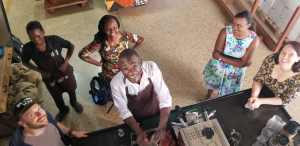
But ‘what’ we are talking about now is a buttery cup with notes of creamy milk chocolate and mild Raisinette acidity. What we have here is a solid 84 scoring lot from a wholly under-appreciated part of the specialty-producing world. A low-acid, big-bodied base blender. An approachable S.O African and, for some, a substitute for more volatile Sumatrans.
More, what we’re tasting is just the start of what is possible from these producers. And that’s what brought me to visit in January ‘19.
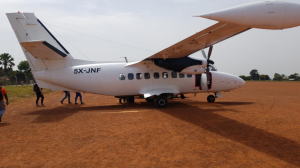
I learned a lot between the boardroom Kampala and an open-aired airport in Arua.
We is me, Jake, and sourcing buddy / extraction and education guru Brandon Birr. The boardroom presentation came from Anneke, head of sustainability for Kyagalanyi Coffee. At the landing strip in Arua we met Emma, head of their operations in West Nile, and another star of this story.
Anneke set the scene, and Emma took the following days to walk us through the rising action.
Paidha, Okoro, Arua, Erussi, Nehuw, Zombo – theses region that add up to West Nile – they are remote, but they have lots of coffee. Click, next slide.
Rich coffee gardens grown under so much shade that the most frequent advice we heard was to ‘open up the canopy’ to increase sun and prevent leaf rust. Click.
While there is a lot of coffee here it comes from small farms; the distances, numbers and complexity of collection add up to a scope of work that intimidates all but the most committed.
While heirloom, the trees are very old, and less than productive. While there is a coffee market, complete with agents, brokers and washing stations –none of this is in support of specialty. Click.
And so, to get to quality, it would take a veritable army of agronomists and technicians. Roving gangs of committed auditors and competent community workers. And lots of long-sighted investment in the pulping, washing, drying infrastructure required by specialty. Click.
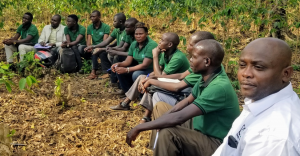
Pulling all of this together sounds a bit optimistic but, on the ground, this is exactly what Anneke and company managed to do. They started an UTZ scheme in 2014 that is now reaching more than 6,000 households with processing equipment, agronomy trainings and other services.
The biggest challenge was how to deal with the pervasiveness of child labor in tending cows, managing market day or in tending coffee. On the surface, the issue is that households with child labor were not allowed to be certified under Utz. This is past tense now as a new standard is emerging, one that recognizes child labor as more of a proxy to the underlying problems of poverty and a child’s right to education. Parents who struggle to pay for uniforms or books draw their kids out of school to help around the house. To send them back they would need not only to pay for school fees, but for extra labor to help around the house.
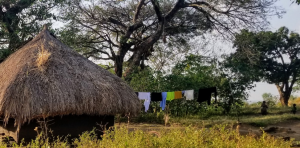
And where is that extra money to come from? Coffee of course. With yields under 1 KG cherry per tree (and a reasonable goal being closer to 8), farmers stand to make more money through improved farm management. Enough to pay for school fees, or hire help and enough to break a downwards cycle.
Step by step, the Anneke and Emma’s team engaged NGOs, local government, churches, mosques, police, and schools to form a ‘child-free labor zone’, a culmination of door-to-door efforts to raise awareness on issues of gender, child-labor and coffee as a business. UTZ is now a project partner, bringing lessons from this work into new RFA standards for child-labor.
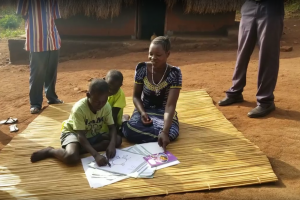
By combining the efforts of UTZ auditors, anti-child labor sensitizers, gender program officers and teams of trained field technicians – the team at Kyagalanyi was able to plug in a missing piece to in the movement to stop child-labor, and extend their purchasing efforts past washing station and bulking centers and into the homes of thousands of farmers.
This may sound like a fluff piece at this point, but what you are reading is genuine appreciation for actual progress from a truly herculean effort.
Every coin has another side, so of course I flipped this story over to take a look at its ugly underbelly.
Maybe that’s just the cynic in me – expecting every positive action to have an equal and opposite negative – but I was all set up to sneer at whatever I saw.
However, what I saw was so boring that I almost forgot to include it here – no uglier than a branded polo, and fixed just as easily. As this little parable will show.
The Youth Teams mentioned earlier, well, when we visited they weren’t working so well. The idea is that it’s pretty darn difficult to find a job if you are 18-24. And it’s also pretty darn hard to properly prune your trees when you are over, say, 64. So why not train a group of young technicians (on donor dollars) so that they can then offer services (for pay) to others in their community? It’s a darn good idea.
But when this youth team shows up with Volcafe logos on their t-shirts it’s thought that they work for, and are paid by, the exporter. So, farmers thought, why pay them yourself?
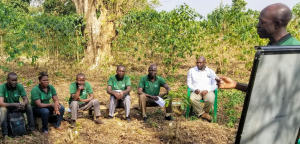
Understandably, the kids don’t want to work for free. And so you can see how this good idea had a hard time getting off the ground.
But it’s a good idea, and one that works in other areas like Mt. Elgon, where farmers have more money, and arguably more of a business mindset to invest in their farms. Also, has more high school graduates, which is the standard for being a member in a Youth Team. More high school graduates looking for work leads to more graduates looking at Youth Teams as a stepping stone in their career. Small fish, big pond type competition – get bigger or get eaten.
Zooming out from this particular parable, international donors have gotten into coffee. USAID, for example, has bought into coffee as a pathway out of poverty. But increased investments require increased accountability, and the those with a track record for managing million-dollar budgets are multi-national companies.* And so, especially in Uganda you’ll see most of the big export shops with internationally-funded projects that help to improve standards along the frontier of coffee.
I had some conflict with this … I first came to Uganda in 2014 to study the ethics and efficacies of a NGO-private company partnership that was going gang-buster with water well development. Still, while I doubt my desire for disclosure will ever be 100% satisfied, I left the trip with more of an appreciation for the impact that donor dollars can have when paired with the private sector.
Zooming back in, the effect is noticeable. Farmers are lining up, one who with genuine tears in his eyes as he described just how important coffee – and Kyagalanyi – was to him. While a drought last year reduced outturns, and prices, overall prices and yields have been up year over year. More, competition has come in, motivating even the most of entrenched of old-school bossman agents to up their game. And word is getting out – while it seems that we were the first buyers to visit these farmers, more and more aid workers have taken note of the work done here, putting West Nile back on the map as an example of child-labor initiatives that work.
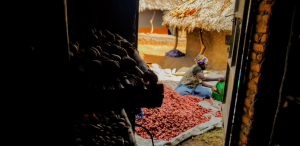
But let’s return to what was a detail in the paragraph above, but a major blip in the lives of these farmers. A drought last year led to poor outturns – an outturn is the % of export-grade coffee that remains after milling. Bad harvest, bad outturns, so prices went down. Makes sense, but it doesn’t have to be.
For example, one item we asked Emma to look into was the math on pre-floating. Floating upon collection, we argued, would make buying more efficient, save on outturns, and lead to better qualities. The idea was that – over a three year period – savings would far outweigh the cost.
Of course there’s massive logistics, training and the ever-critical execution. But what we’re talking about here is buying 108 plastic garbage bins – drilling holes in half and sticking them in the other half and make 54 float bins. They save on water and time; you can even spin the interior drum to float cherries by centrifugal. These bins would then go to the 52 bulking centers, with two for the main washing station.
Still, that’s a big undertaking, and the numbers would need to make sense on their own – savings through improved outturns would need to make it worth the while; eventual higher prices for quality could come later as a bonus on top. In this dance coffee leads and the buyers follow. But Emma is an interesting and motivated man – just the type of guy who might take to an idea like this.

Emma, pictured above in green
The next idea we left with Emma was to create an additional classification of coffee. Right now, there are there grades; collection agents just look at parchment and assign it as ‘standard’, ‘standard plus’ and ‘premium’. One of the larger collectors told me that collections were roughly 1/3rd for each.
The idea, I pitched, was a fourth category – call it ‘super premium’. Super premium is best-looking coffee from top farmers in the top areas. It would represent the top 10% of the premium category, and be kept separate long enough to cup. If this is possible next year, I don’t know. But I am hopeful that this seed will grow. Because how cool would it be to see areas like Zeu, Kango and Atyak earn a name for themselves?!
I know, we were demanding. And we were not done. One last thing we asked was how, next time we come back, we could find them drinking their own coffee!
The response was to get a roaster, grinder, kettle and brew setup in place for education. The goal is to at least taste the difference between the three (hopefully four) grades of quality; the cup can connect practices at the farm to prices at the mill. And at the best, samples could be brought to here from different collection areas and evaluated – allowing Emma and company to paint a map of the diverse flavor profiles to be found across the larger region.
And yes, this was a selfish request as well. Not only should this help them to supply better coffee, but it sure will be nice to get a cup next time I visit. A visit I’m already looking forward to.

If you read this far, you might make it as far as trying some coffee from West Nile. This region is on the up, and worth a look for those frustrated with Sumatra or otherwise on open to a new base for their iced or espresso blends. I’m off to research the equipment I promised, but as always feel free to contact me with any questions or interest.
*The project discussed here was funded in part by aBI Trust – a donor collective that includes Danida, the Dutch Government and USAID. And while these organizations are investing millions into coffee, the budget for this project is a step above bootstrap and not near that range.
Read more about the work of our producing partners here and look out for the offers coming from this region.